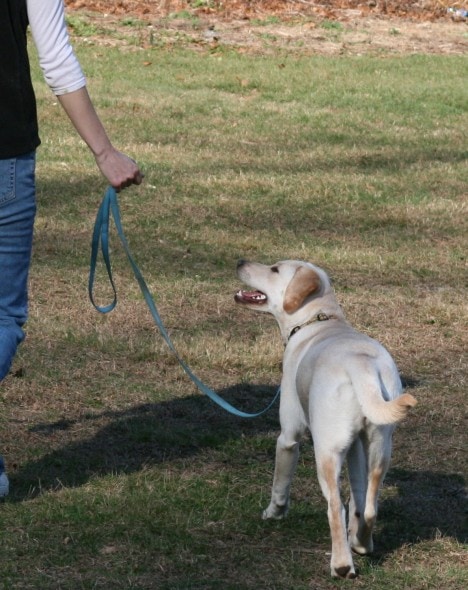When a dog pulls excessively on leash, it is unpleasant for both the dog and the person walking him. Many people resort to yanking on their dogs, using pinch or choke collars, or stopping every few feet hoping for something to change. Using a choke chain or pinch collar may lessen pulling temporarily, but these collars are very unpleasant for your dog and can be physically damaging. Trying to force your dog to walk behind you can be just as unpleasant. However, there are many fun, motivating, and gentle ways to lessen your dog’s pulling. By following the below tips, your walks will improve with your dog and you will both enjoy walking together.

You can also shape attention by simply praising and treating your dog every time he looks at you or glances in your direction while on a walk. Your dog will look at you and check in with you more frequently. If your dog obsesses over you, looking for food, ignore him for a little while. Wait until he stops focusing on you or he looks at something else and becomes mildly distracted. Make the fun attention noise you’ve been shaping. The moment your dog looks at you, praise him and give him a mouth-watering treat. Your dog will begin to look at you when there are distractions outside. Keep rewarding your dog until he checks in with you regularly. Your dog will naturally start to look at you for guidance and direction.

3) Make walking fun! Your dog’s walk is for his benefit. It is his time to de-stress and enjoy himself. People often are impatient when dogs stop to sniff on walks or when they stop to look at something. They pull or yank their dogs to follow them. Allow your dog to sniff on walks. He will enjoy his walks more and therefore, will be more responsive to you when you give him an instruction or want him to follow you. When your dog stops to look at something, let him. Then say “Let’s go” and praise him for continuing to walk with you.
If you have a dog who likes to chew, take balls or sticks on the walks with you. Let your dog chew or play with the toys, balls, or sticks while you walk together. Your dog will enjoy his walks and your company. He will be much more interested in you, and there will be less disconnect or conflict on the leash.
4) Speed up your walks and vary the pace. Dogs have four legs and a low center of gravity. They walk faster than most people run. Forcing a dog to walk behind you is uncomfortable and extremely unpleasant to him. It sets up a confrontation with your dog when there is no need for one. By quickening the pace of your walk, your dog will pull less and he will get more exercise. If your dog wants to walk quickly, pat your thigh and say “Quickly,” then run with him. Reward him for running with you. Slow down, and then praise and treat him for walking with you again. By allowing him to walk at a more normal pace for him, he will be more relaxed and more attentive to you.

In summary, by praising and rewarding your dog for looking at you, turning with you, and stopping when you do, and by making walks fun and interesting for your dog, he will be more attentive and responsive to you. You’ll both be able to enjoy walks again.
Copyright © Alana Stevenson 2012
Alana Stevenson is the author of Training Your Dog the Humane Way and The Right Way the First Time. She can be contacted through her website AlanaStevenson.com. She provides consultations through phone and Skype.
